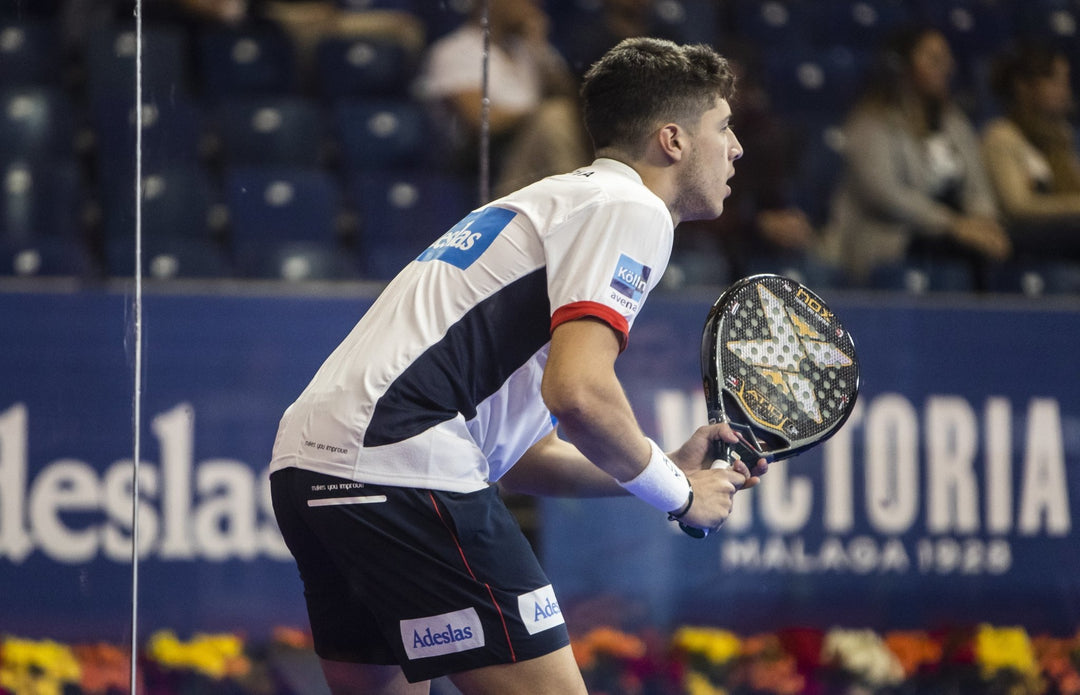How to do the drive or right-hand drive stroke in padel
The drive stroke in padel tennis is considered, along with the backhand, one of the fundamental strokes. As you all know, the movement of the drive is used at the moment of the serve, in the rest of the forehand, in the counterblow, etc. For this reason, it is very important to do it well and thus be able to advance your padel level.
The drive is a basic stroke and requires a lot of control, which is why we recommend that you execute it without much speed, this way you will get more ball control and you will be able to determine the effects of your shot, short and long strokes, etc.
That said, what are the phases of the drive stroke?
Preparation or waiting phase

The waiting phase is usually the first phase for any of the shots we take from the bottom of the court. Before making the drive stroke:
1.Stand well towards the side, with your feet pointing towards the side wall.
2.Semi-flexed legs placed at shoulder height.
3.Move around. Move your feet from side to side as if you were swinging. Any of the movement options you make is good, the important thing is to avoid staying still.
4.Keep your arms close to your body.
5.The body has to be oriented towards the opponent who has the ball.
6.The weight of your body should be slightly forward.
Shot phase

The most important thing for padel is to always turn your shoulder towards the net.
To do this, follow the instructions below:
1.Turn your shoulders and step backwards to stand completely sideways to the ball. Your left shoulder should point to the ball and your left hand should point to where the ball is going.
2.Adjust the distance from the racket to the ball with small steps depending on how the ball comes towards you.
3.When you start to prepare the stroke, it's important that the racket is at waist height level and that you aim the frame forward.
4.Bring the racket back so that it points to the wall at the back. Try not to carry the racket too far back, the limit is your own vision (do not lose sight of the racket by bringing it too far back).
5.Keep your arms relatively close to your body so that you can execute a more natural stroke.
Hitting phase

Once you've prepared your shot, it's time to strike:
1.Carry your weight on your front foot (left foot if you are right-handed or right foot if you are left-handed) to transmit your body weight from back to front.
2.Depending on the height of the ball you will have to bend more or less. If the ball is low, you will have to bend more and hit closer to the ground.
3.Strike
4.The stroke is made between the knee and the hip.
5.What will differentiate a flat forehand from a cut or a top spin is the following:
a. Drive or Flat forehand: with the racket totally perpendicular to the court, hit the ball right in the middle. The racket will end up at shoulder height.
b. Drive or Forehand cut: with the upper part of the racket rotated a little backwards it hits the ball in a downward direction: from top to bottom. The racket will end up between your hip and your shoulder. The characteristics of the ball in this type of forehand are to go to maximum effect but slowly and with as much depth as possible, and its main objective is to go up to the net and win it.
c. Drive or Right top spin: with the top of the racket rotated a little forward, it hits the ball upwards: from bottom to top. The direction of rotation we give the ball is forward, tracing a parabola, which makes the ball come out higher than with the cut or flat right stroke. The racket will end up below the hip. With this effect, the ball will go over the net with a pumped effect and will fall faster to the ground.
7.The feet remain in the same position without taking any additional steps.
During the hitting phase it is important to know that:
●If the ball is above the waist, you can choose to play with a forehand cut.
●If the ball is below the waist, it's better to opt for a top spin (in this case it's easier to hit if you relax your arm and hit the ball when it starts to fall). You can also play with a flat forehand.
Depending on where you play on the court and where you want to throw the ball, you must hit in front of the body or hit at the same height as the body, and it will be the shoulders in general that will mark the direction of the ball.
Once you've finished your shot, remember to reposition yourself to continue playing.
Check out the video attached to the article to see in detail how Agustín Tapia, Mapi S. Alayeto and Miguel Lamperti, three #TeamNox magicians execute this shot. They always make sure we enjoy their game in every match.
At Nox we want to bring the whole padel tennis world to you in the simplest way possible, our mission... "Makes you better". If you liked this article... SHARE IT!
You may also be interested in...
 |  |  |
| HOW TO DO THE OFF THE WALL SMASH IN PADEL | TIE BREAKING: HOW DOES THE SERVE ORDER AND POINTS SYSTEM WORK FOR A TIE BREAK? | HOW TO PERFORM A GOOD SERVE WHEN PLAYING PADEL |










